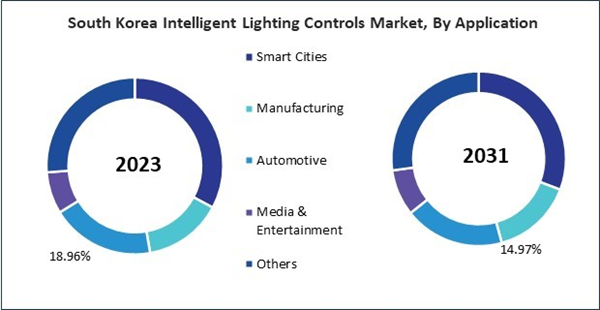The China market dominated the Asia Pacific Intelligent Lighting Controls Market by Country in 2023, and would continue to be a dominant market till 2031; thereby, achieving a market value of $3.60 billion by 2031. The Japan market is registering a CAGR of 17.7% during (2024 - 2031). Additionally, The India market would showcase a CAGR of 19.3% during (2024 - 2031).
Public areas benefit from intelligent lighting controls that enhance safety, reduce energy consumption, and support smart city initiatives. Adaptive lighting systems adjust brightness levels based on pedestrian and vehicular traffic patterns, improving road visibility and safety while minimizing energy waste during off-peak hours. Outdoor lighting controls incorporate motion sensors and dimming capabilities to conserve energy and reduce light pollution, creating a more pleasant environment for park visitors and wildlife.
These lighting controls enhance guest experiences and operational efficiency in entertainment venues and hospitality establishments. Lighting designs are synchronized with stage productions and events, utilizing color-changing capabilities and automated cues to create immersive atmospheres and visual effects. Lighting scenes can be adjusted to enhance dining experiences, complement interior designs, and create ambiances that align with the venue's brand and customer preferences.
The expansion of smart manufacturing in South Korea drives demand for integrated smart building technologies, including these lighting controls. These controls are deployed in industrial facilities, warehouses, and assembly lines to support adaptive lighting scenarios, asset tracking, and facility management. Integrated lighting systems enhance operational agility, optimize space utilization, and facilitate data-driven decision-making in South Korean manufacturing environments. Korea's private and public sectors have committed to expanding the number of smart factories within the country, aiming to reach 30,000 facilities equipped with cutting-edge digital and analytical technologies by 2023. In conclusion, rising smart manufacturing and expansion of the region's media and entertainment industry are driving the market's growth.
Based on Connectivity Type, the market is segmented into Wired and Wireless. Based on Type, the market is segmented into Sensors, Ballast & LED Drivers, Microcontrollers, Dimmers & Switch Actuators, Transmitters & Receivers, and Others. Based on Application, the market is segmented into Smart Cities, Manufacturing, Automotive, Media & Entertainment, and Others. Based on countries, the market is segmented into China, Japan, India, South Korea, Singapore, Malaysia, and Rest of Asia Pacific.
List of Key Companies Profiled
- General Electric Company
- Cree, Inc. (SMART Global Holdings, Inc.)
- Honeywell International Inc.
- Eaton Corporation plc
- Cisco Systems, Inc.
- Siemens AG
- Acuity Brands, Inc.
- ams-OSRAM AG
- Signify N.V.
- Panasonic Holdings Corporation
Market Report Segmentation
By Connectivity Type- Wired
- Wireless
- Sensors
- Ballast & LED Drivers
- Microcontrollers
- Dimmers & Switch Actuators
- Transmitters & Receivers
- Others
- Smart Cities
- Manufacturing
- Automotive
- Media & Entertainment
- Others
- China
- Japan
- India
- South Korea
- Singapore
- Malaysia
- Rest of Asia Pacific
Table of Contents
Companies Mentioned
- General Electric Company
- Cree, Inc. (SMART Global Holdings, Inc.)
- Honeywell International Inc.
- Eaton Corporation plc
- Cisco Systems, Inc.
- Siemens AG
- Acuity Brands, Inc.
- ams-OSRAM AG
- Signify N.V.
- Panasonic Holdings Corporation









